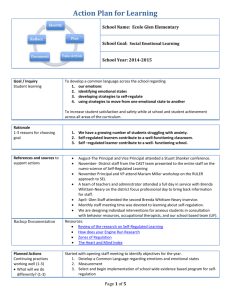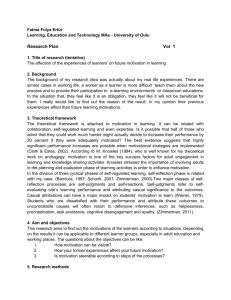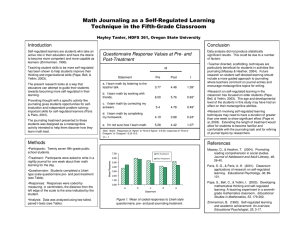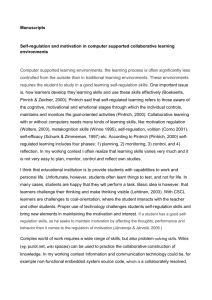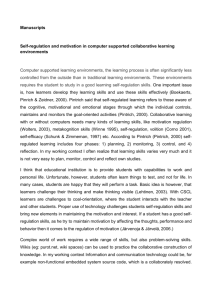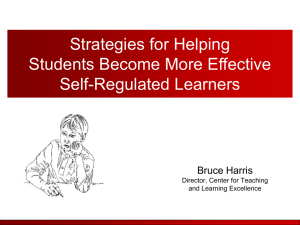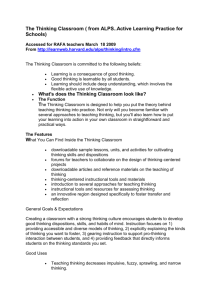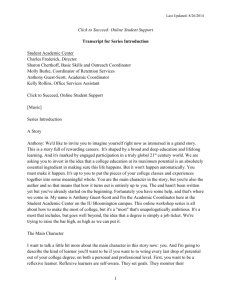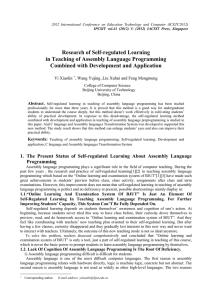Assessing Student Success: A Discussion of Outcomes in
advertisement
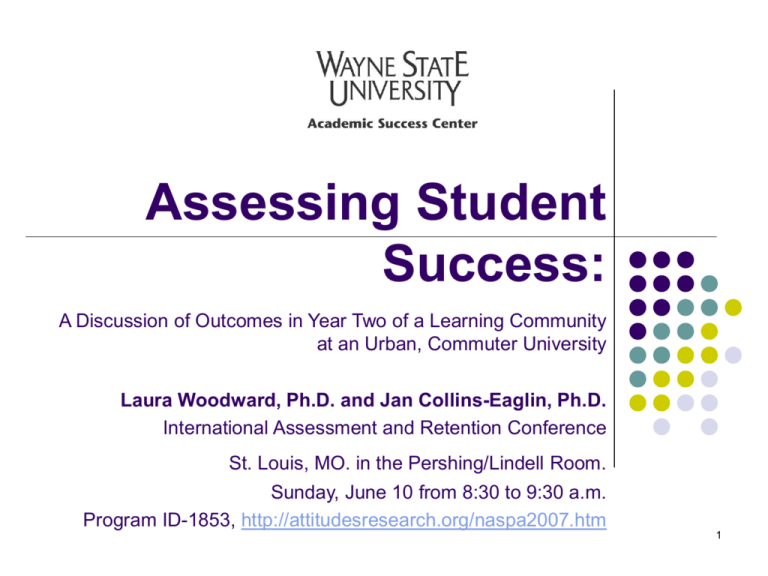
Assessing Student Success: A Discussion of Outcomes in Year Two of a Learning Community at an Urban, Commuter University Laura Woodward, Ph.D. and Jan Collins-Eaglin, Ph.D. International Assessment and Retention Conference St. Louis, MO. in the Pershing/Lindell Room. Sunday, June 10 from 8:30 to 9:30 a.m. Program ID-1853, http://attitudesresearch.org/naspa2007.htm 1 Goals of presentation To discuss techniques to assess a multi-cultural learning community. To demonstrate multi-cultural components of selfregulated learning. To describe how the self-regulated learning paradigm can help staff systematize assessment. 2 Our cohort High-achieving high school graduates from an urban, predominantly African American school district. Archives indicated performance lower than expected. (Reaves, Woodward and Collins-Eaglin, 2005) This project documents the success of this group following intervention. 3 Intervention A learning community A first year experience course Weekly instruction regarding study strategies The textbook, Learning to Learn, was used. Taking courses as a cohort Intrusive advising Peer mentorship Get-togethers 4 Description of the program This learning community provided a social community with a focus upon academic achievement. Academic, social and academic integration (Tinto, Goodsell, & Russo, 1993). Achievement and social and emotional well-being. (Wentzel, 1999) Another important component of the program was its emphasis upon academic ability as being improvable through effort. (Aronson, 2005; Aronson, Fried, & Good, 2002). ) 5 Conceptual foundation Self-regulated learning A theory that tries to look at these three aspects holistically: Skill Will What skills does a student need to get through academic material? How does the student stay motivated to get those skills? Self-regulation How do they regulate motivation and skill building even when it is hard? 6 Self-regulated learners Self regulated learners are motivated, set goals to strive for in their learning, have a high sense of selfefficacy, and set expectations for their learning. They are active in monitoring, adapting and controlling their learning. 7 Strategies that students use include: putting time and effort into planning keeping track of how much effort, time, and help they need making choices about whether to increase or decrease their effort sticking to it regulating how much effort to put forth using self-talk that emphasizes the importance of effort using help-seeking to be successful 8 Motivation and beliefs Motivation to improve abilities is enhanced by student beliefs that abilities are malleable, and that effort and strategies can improve abilities. This goes against past descriptions of intelligence as genetic and fixed. Research shows that greater performance, academic engagement and enjoyment of the academic process is evident in students who are encouraged to think of intelligence as malleable. (Aronson, Fried and Good, 2002; Hong, 2001; Hong, Chiu, Dweck, Lin & Wan, 1999) 9 Bernard Weiner's Attribution Theory 10 Motivation and effort Uncontrollable Controllable Internal Ability Effort Luck External Help from others Task difficulty 11 Motivation in self-regulated learning for African American students Belonging Achievement in college is related to feelings that one is accepted by a group that values high achievement. (Wentzel, 1999) Learning is facilitated by teaching one another and helping one another feel a sense of belonging. (Aronson, 2005) Effort matters Helping students to understand that intelligence is malleable increases Effort Joy in challenge Risk-taking Pleasure in learning (Aronson, 2005) 12 Method A mixed methods approach. Formative measurement Summative measurement Two cohorts were compared. Both cohorts 2005 (without intervention) 2006 (with intervention) Were gifted students from Detroit Public Schools Received a full tuition scholarship based on their academic achievement in high school Intervention Learning community 13 Technology Assessment was facilitated by the use of Blackboard’s online survey software. 14 Goals for assessment Goals for our students: A feeling of belonging Gaining strategies of a self-regulated learner According to the selfregulated learning literature, improvement in these areas is related to: Improved grades Improved retention 15 Formative assessment Documented challenges and strengths Social community 23% of the comments related to the peer support. Self-regulated learning techniques 24% of the comments related to study skills and time-management What has your learning community done so far this semester which contributed to your academic success? Time-management 6% Mentorship 6% Peer support 23% How to adapt 6% Nothing 12% Accountability 17% General success 12% Study skills 18% 16 Self-regulation: Study strategies they realized they worked “I have learned to take big What was the most important thing you learned this semester? projects one piece at a Study time. In addition I have used 10% a planner to keep me on I can do well 10% task.” Time-management 40% “I have actually studied. That Career 10% is so major. In High School, I could blow off my classes Be organized 10% and still pull off an A. But in Stay motivated College if I am off track for a 20% couple of days, my grade is hurt severely.” 17 Self-regulation: Study strategies they realized they needed What could you have done differently to improve your academic su Study skills • “To improve my academic success I could have studied more for my tests in Chemistry. I could have performed better on my quizzes and took more time out of my schedule to focus more on my courses.” Use resources 6% Scheduling 6% Workload 13% Study skills 31% Time-management • “I waited to the very last minute to do many assignments. If I could go back, I would do things earlier so I wouldn't have to work and cram the night before on an assignment.” Attending class • “I could have not missed any classes which would have helped me not to be so behind.” Attend class 19% Time-management 25% 18 Self-regulation: Noticing what works and making changes to increase learning I had another quiz in Algebra and the rehearsal technique was a very effective way for me to study. It’s hard to sit in a lecture for two hours. But I just remind myself that I have to pay attention if I want a good grade and that I cannot get into medical school without good grades. I have been studying at the library but I noticed that when the weather turns cold, it gets kind of noisy up there. I may start looking for a different place to study. When I feel myself becoming frustrated, I take a break. I usually feel better after a break. Now before I do a reading assignment, I briefly skim the chapter first. I learned this week that I am most productive at night. I am a very social person and so when others are having fun, I want to have fun with them. But at night, it is only me, my computer and my thoughts. I focus better at this time of day. I have noticed that I tend to drift off in government class when the professor lectures. I will try to refocus my energy and listen by making myself look into the professor’s eyes so that I can get an idea of how the professor feels about what he is saying. To keep myself paying attention, I pinch myself so that I will stop falling asleep. The other way I stay awake is by taking notes and finding interesting things about the subject. Comments from students’ journals and the portfolios. 19 Summative assessment 3.5 3 2.5 LC 2.9 No LC 2.26 88% 86% 2 84% 1.5 82% 1 80% 0.5 78% 0 76% Academic Achievement: GPA first semester N no learning community =16 LC 88% 90% No LC 81% Retention: Percent retained for the first year N learning community =25 20 Compilation Our approach worked: Formative analysis indicated that friendships and study skills helped students stay on track academically. Summative analysis indicated higher grades and increased enrollment. 21 Conclusions How the self-regulated learning paradigm can help staff systematize assessment: Study strategies Friendships Meta-cognition Multi-cultural components of selfregulated learning. Sense of belonging Importance of effort Techniques to assess a multi-cultural learning community. Formative Summative 22 References Aronson, J., (2005) Stereotypes and the Fragility of Human Intelligence. A presentation at the American Psychological Association Convention. Retrieved online at http://www.apa.org/ed/topss/05topss_speaker.html on 6/4/2007. Aronson, J., Fried, C., & Good, C. (2002). Reducing the effects of stereotype threat on African American college students by shaping theories of intelligence. Journal of Experimental Social Psychology, 38, 113– 125. Chiu, Chi-yue, Ed.; Salili, Farideh, Ed.; Hong, Ying-yi, Eds. Multiple Competencies and Self-Regulated Learning: Implications for Multicultural Education. Research in Multicultural Education and International Perspectives. Information Age Publishing: Greenwich, CT. Hong, Y. (2001). Chinese students’ and teachers’ inferences of effort and ability. In F. Salili, C. Chiu, & Y. Hong (Eds.), Student Motivation: The Culture and Context of Learning. New York: Kluwer/Plenum, 105-120. Hong, Y.-y., Chiu, C.-y., Dweck, C. S., Lin, D. M. S., & Wan, W. (1999). Implicit theories, attributions, and coping: A meaning system approach. Journal of Personality and Social Psychology, 77, 588-599. McInerney, D. M., & Van Etten, S. (Eds.). (2001). Research on Sociocultural Influences on Motivation And Learning, 1. Greenwich, CT: IAP. Pintrich, P. R., Zusho, A., Schiefele, U., & Pekrun, R. (2001). Goal orientation and self-regulated learning in the college classroom: A cross-cultural comparison. In F. Salili, C-Y. Chiu, & Y-Y. Hong (Eds.), Student Motivation: The Culture and Context of Learning. New York: Plenum. 149-169 Purdie, N., & Hattie, J. (1996). Cultural differences in the use of strategies for self-regulated learning. American Educational Research Journal, 33, 845 – 871. Reaves, R. Woodward, L. and Collins-Eaglin, and J. (2005). Retaining the Academically Talented Student. Presented at the Twelfth National Conference on Students in Transition, held November 6-8, 2005, Costa Mesa, California. Tinto, V. (1997). Colleges as communities: Exploring the educational character of student persistence. Journal of Higher Education, 68(6). Tinto, V., Goodsell, A., & Russo, P. (1993). Gaining a voice: The impact of collaborative learning on student experience in the first year of college. Unpublished manuscript. Syracuse University, Syracuse, New York. Wentzel, K. R. (1999). Social-motivational processes and interpersonal relationships: implications for understanding motivation at school. Journal of Educational Psychology, 91, 76}97. Weiner, B. (1986). An attributional theory of motivation and emotion. New York: Springer-Verlag. 23

